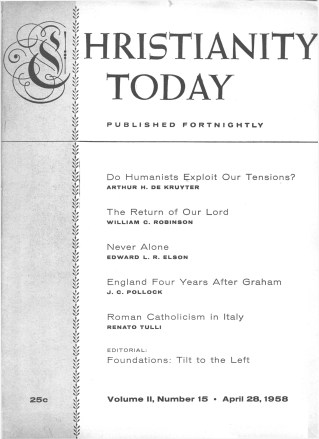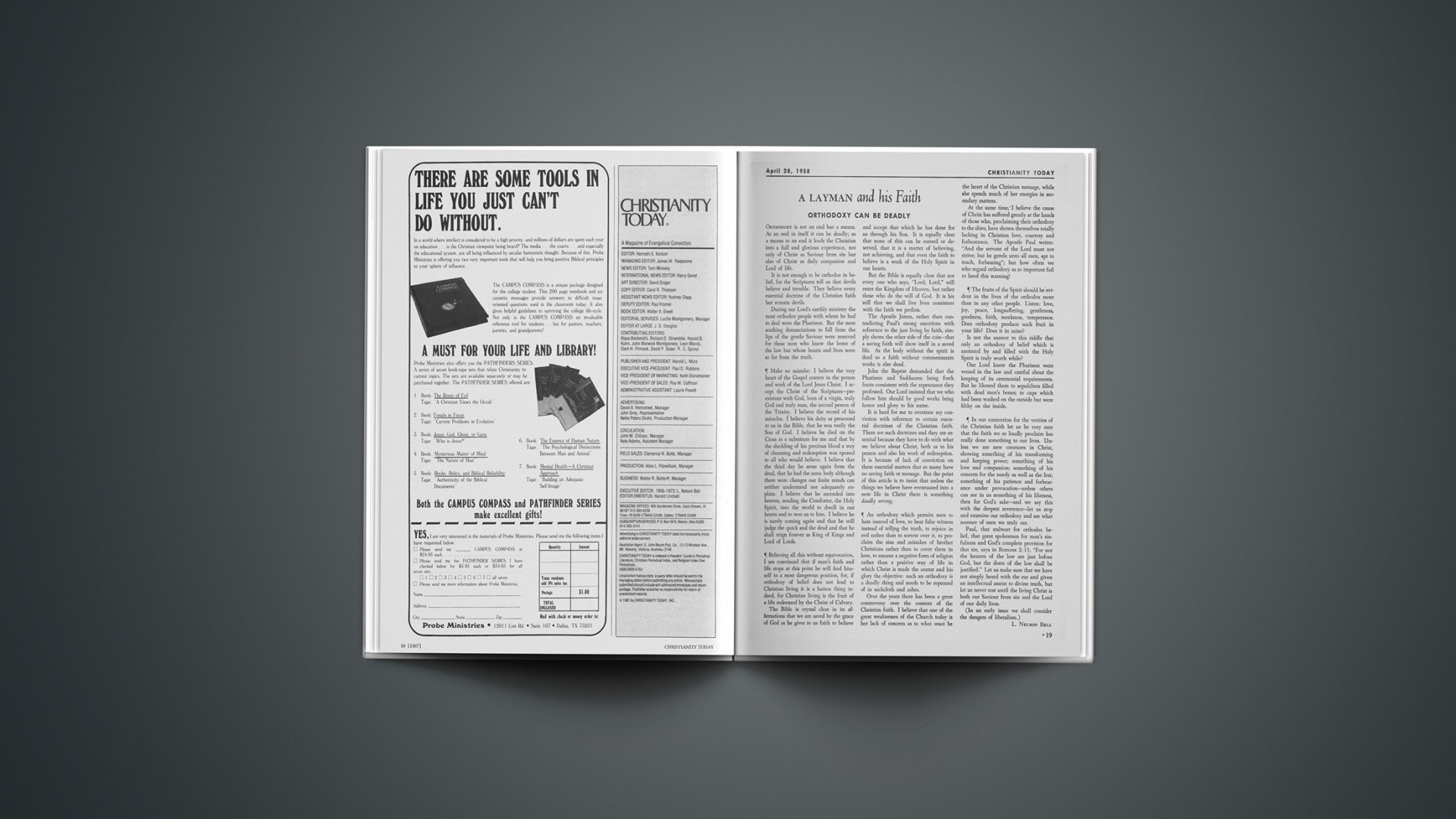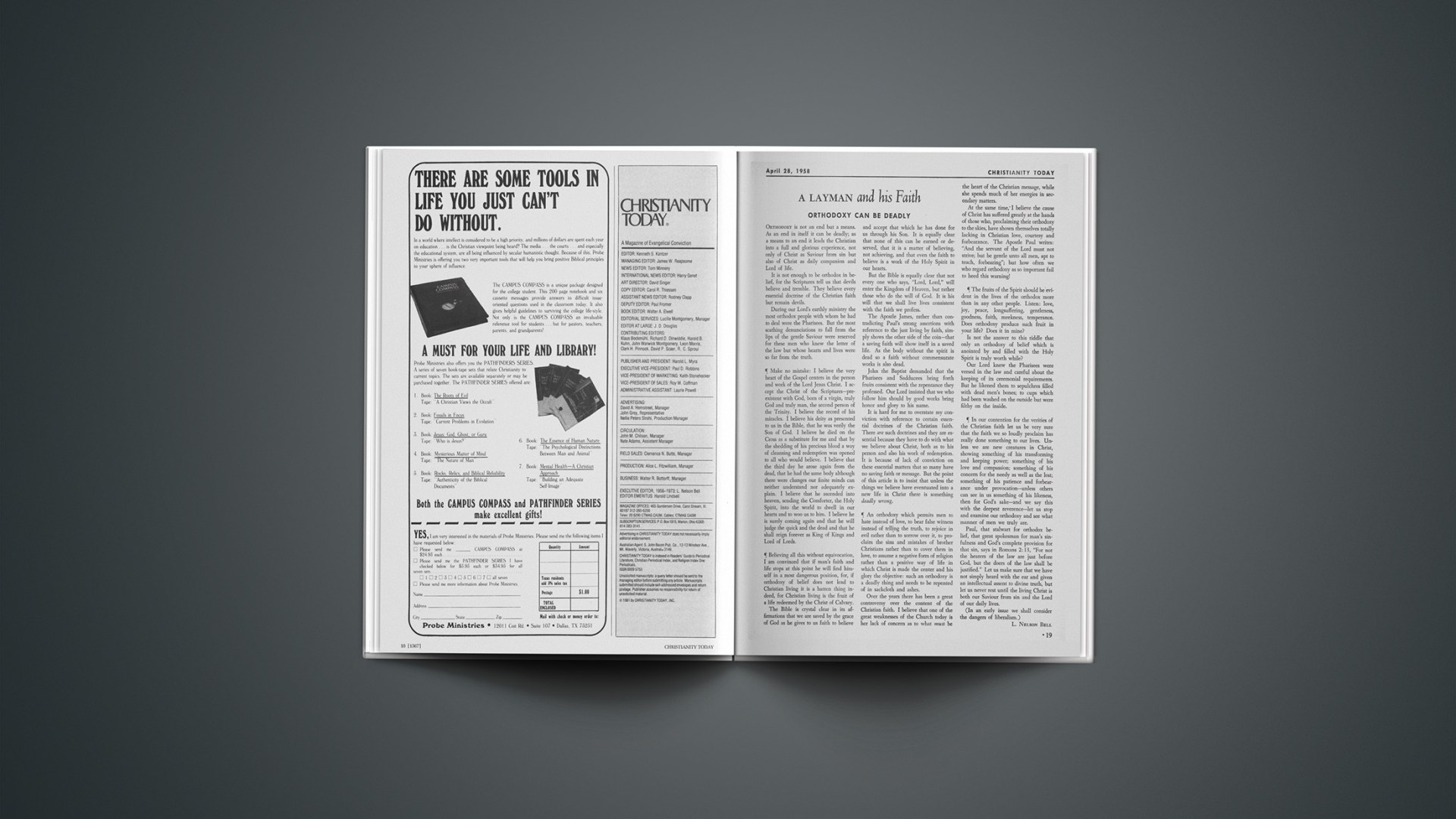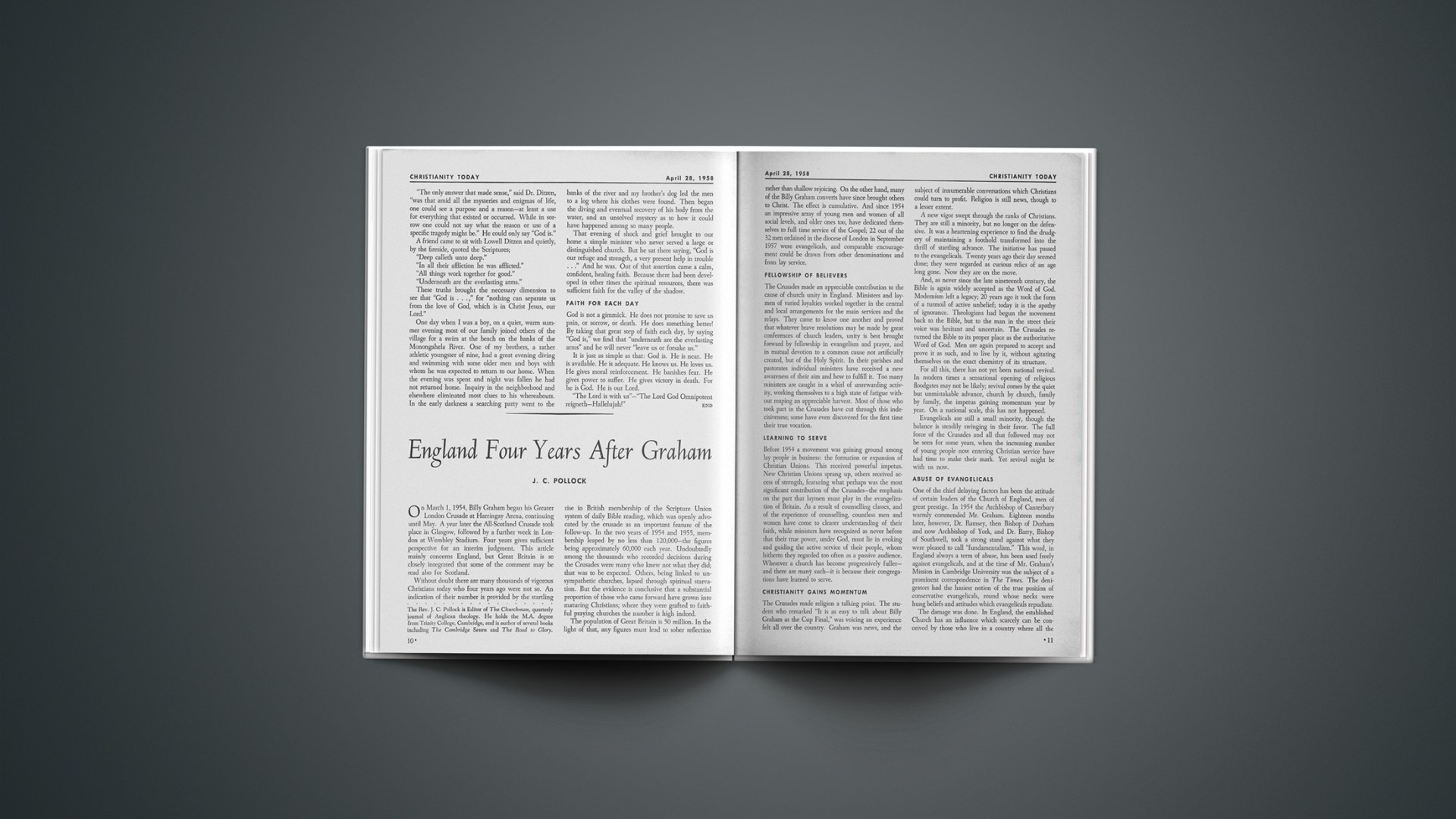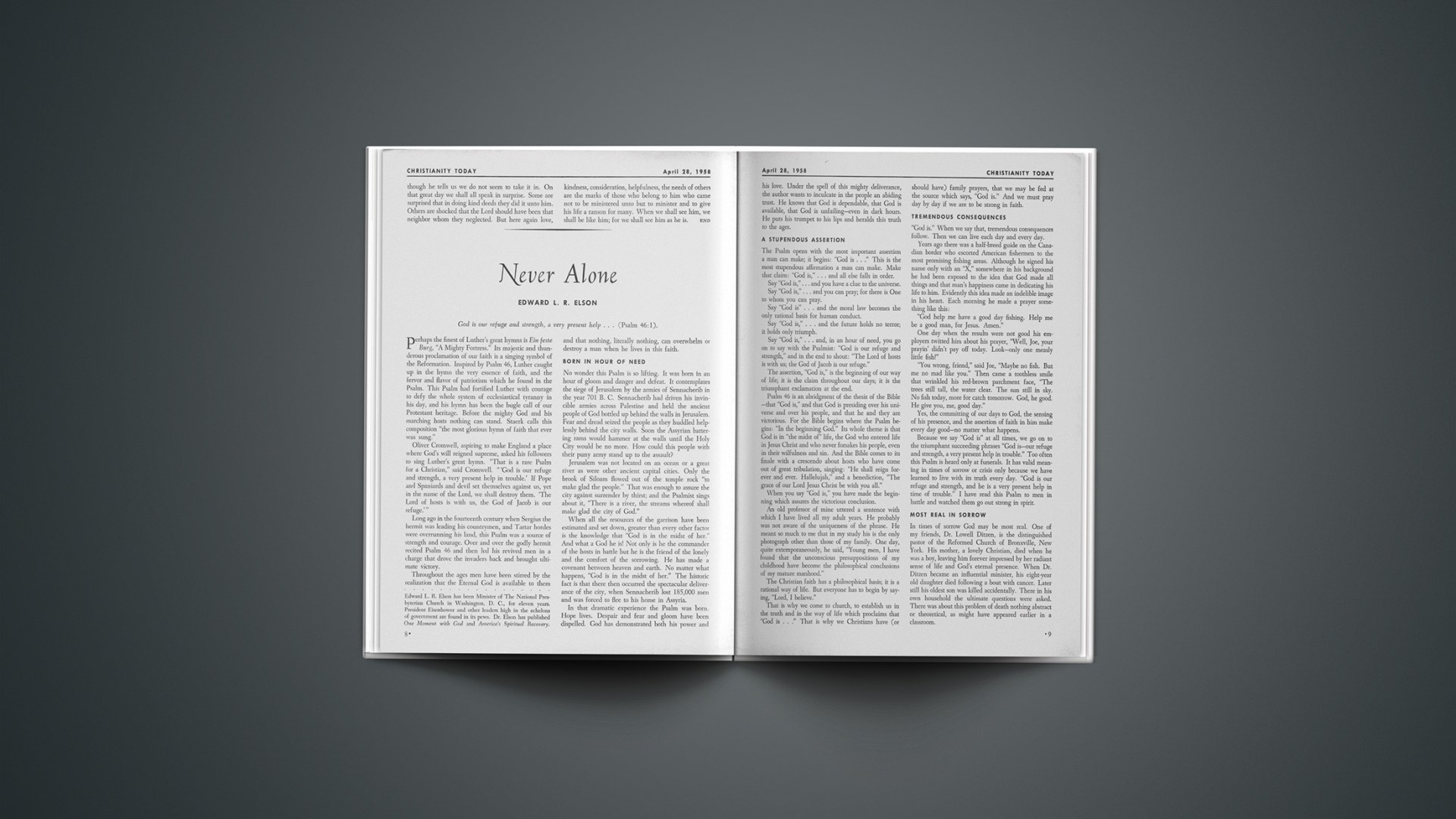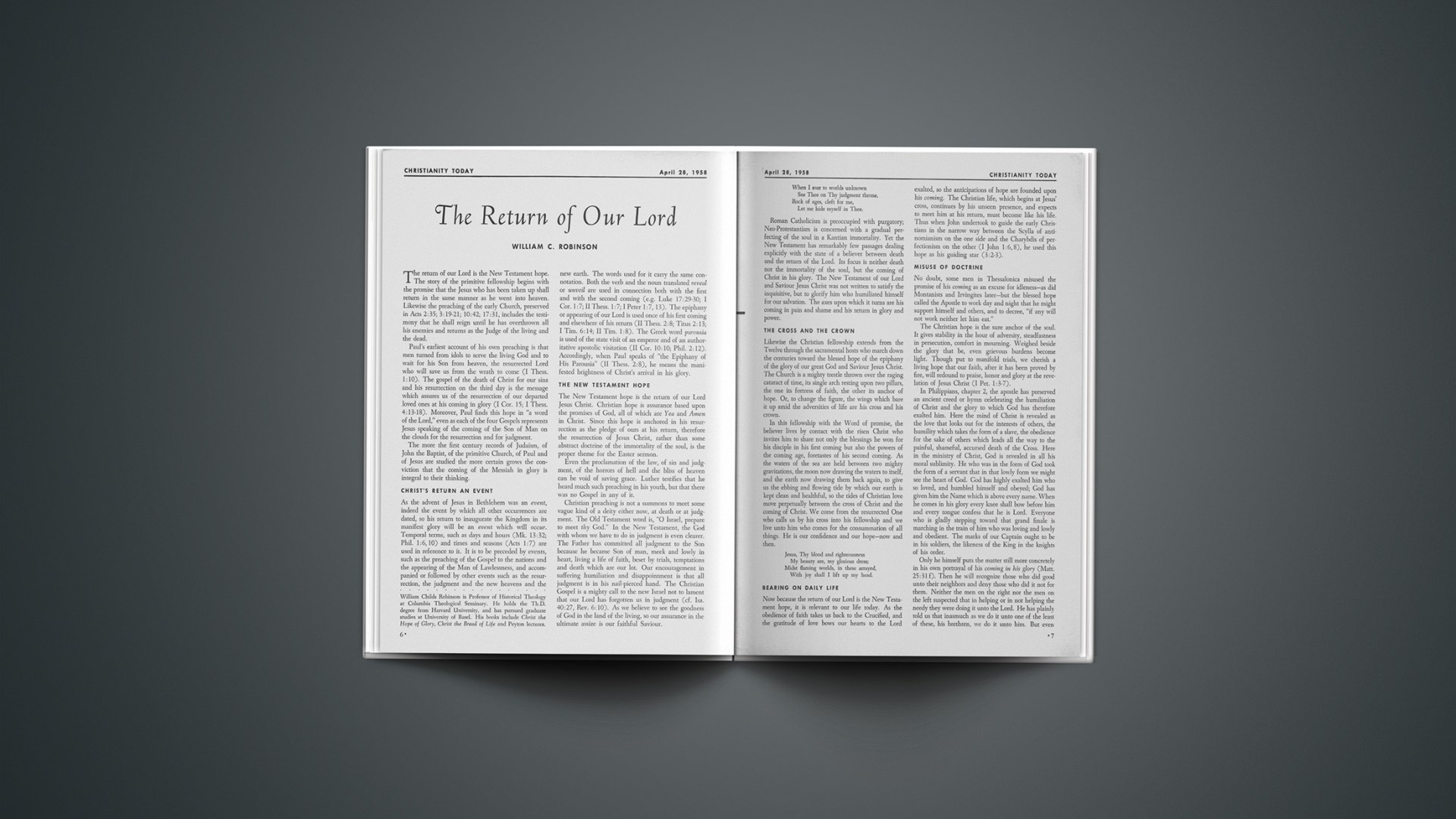COMPARATIVE ECCLESIASTICS
At the Women’s Auxiliary Buffet, Pastor Weems, Dr. Ivy, and Dean Drinkwater were chatting as Weems finished a second slice of chocolate whipped cream cake. Studying the trio, I was reminded of the importance of Comparative Ecclesiastics, the psychosomatic study of atypical clergy. The following introductory descriptions are of value to research assistants, pulpit committees, and prospective ladies of the manse.
Ecclesiastics Ectomorphus. Solid supporter of church suppers, bake sales, teas. Often visits in the homes of his parish to encourage hospitality. A weighty opponent of asceticism. Prefers Genevan robe in pulpit (52, short). Jolly sermonettes a specialty.
Clericus Mesomorphus. Enthusiastic keystone of young men’s activities, notably at second base on the soft-ball team. Develops small group emphasis throughout the church year: bowling, basketball, tennis, golf in season. Muscular preaching with booming cross-nave volley. Casualties from handclasps at the door.
Doctorandus Endomorphus. His immortal sermons never die, they just fade away. He carries the groceries with a scholarly stoop and drives his vintage Packard with philosophic detachment. He can sometimes recall the name of a parishioner by associating him with a Continental scholar.
Predicandus Amorphus is all things to all men. An evangelicalliberal with leanings toward and away from neodoxy and paleoism. Heartily concurs in both sides of every argument—with minor reservations. Man of many deep convictions which last for days.
Your cooperation is invited in compiling profiles of other notable types. Studies are in progress on Tyranothesaurus Rex who hurls synonyms like thunderbolts and defies you to break into his conversation, and Dialecticus Non Dubitandum.
EUTYCHUS
THE GRAVECLOTHES
Hillyer Straton’s article on the resurrection of our Lord (Mar. 31 issue), on the whole, was very well done. For me, however, the paragraph about the napkin that had enwrapped the head of Jesus, left something to be desired.… What convinced John that Jesus had risen as he promised was the fact, obvious from their position, that no human hands had touched these graveclothes to empty or rearrange them. For the body indeed was gone. The physical remains had been transformed on the third day into that wonderful and incorruptible thing St. Paul called the “spiritual body.” But the linens still lay in the place where the head and torso of Jesus had rested. They had, however, collapsed from the weight of the spices. The Greek word translated “rolled up” in the Authorized Version and “wrapped together” in the Revised Version, used to describe their condition, does not mean that the linens had been folded and placed in piles. On the contrary, it means that as the linens collapsed they retained the annular, ringlike shape that had been given them by the use to which they had been put. Such a sight would indeed open the eyes of one who had the capacity for insight enjoyed by the Beloved Disciple.
So we read (John 20:8), John “saw, and believed.”
Wichita, Kan.
THE CROSS
Your editorial on “Preaching the Cross” (Mar. 17 issue): we distinguish between the fact and the philosophy of the Atonement.… By the Atonement as fact we understand the gracious work of the Lord Jesus for the blessing of men. All else is theory and mode of putting. One might well hold fast to the fact with all conviction and devotion, and at the same time find no acceptable theory.
Nobleton, Fla.
Your editorial … rates the highest comment of praise! May the all-sufficient grace of God lead you to give us more editorials of this sort!
St. Paul’s Lutheran Church
Vincennes, Ind.
In the Roman Catholic church the crucifix stands upon or over the altar. In this house, in every chapel, in every room there is a crucifix.… The Protestants are the ones who have removed the cross from the buildings and from their altars and from their homes.
The Order Of The Holy Cross
West Park, N. Y.
LIBERTARIANS
I wish to express my appreciation to you for … one of the finest magazines of its sort to which I have ever subscribed.… I feel compelled, however, to protest about … “Christ and the Libertarians” (Mar. 17 issue).… It seems to me to be a tragic mistake to interpret evangelical Christianity as being favorable to economic or political fascism. As a fundamentalist, I am convinced that the so-called “creeping socialism” of the New Deal was far closer to the Christianity of the Bible than anything set forth by those peculiar organizations to which Mr. Howard makes reference.
First Presbyterian Church
San Diego, Calif.
I take exception to Mr. Howard’s article. I have long been dissatisfied with the “social gospel” approach and cannot always agree with the National Council of Churches. I support the Spiritual Mobilization movement as a libertarian, and think that you have done that organization a grave injustice by allowing such an un-Christian, humanitarian, bigoted movement as the Christian Freedom Foundation to be compared with the high, spiritual, Christian purposes of Spiritual Mobilization!
Union Presbyterian Church
Lost Nation, Iowa
Christian Freedom Foundation has been called many things, but I think this is the first time we have been charged with humanitarianism! That label we accept! We are humanitarian! We believe in seeking the welfare of man—under God—and are convinced that the welfare of man is advanced better in a free society than in any kind of a socialistic system.
With that Spiritual Mobilization would agree also. In fact, the Christian Freedom Foundation and Spiritual Mobilization would agree on their political and economic views anyhow. The only difference, which I pointed out in the article in question, is a difference of emphasis. Christian Economics has been more biblical and evangelical. This is not to say that what Faith and Freedom has published has not been true. As a former writer for that publication, I certainly hope that was the case.
Christian Freedom Foundation, Inc.
New York, N. Y.
“Christ and the Libertarians” was of particular interest. It has always seemed to me that the Scripture as a whole upholds our so-called “American way of life”—private ownership of property, employer and employee, etc., rather than depending so much on government. The article brings out many factors of truth on the question.
Publisher
Martinsville Daily Reporter
Martinsville, Ind.
Inasmuch as there can be no genuine morality apart from the regenerating influence of the Holy Spirit, we conservatives should be in the forefront of a movement to restore freedom to our land, whether it be religious, political or economic.…
Chapelgate Lane Church
United Presbyterian
Baltimore, Md.
THE FINAL TEST
I wish to heartily commend L. Nelson Bell’s “Bricks Without Straw” (Mar. 17 issue). Dr. Bell’s contentions are profoundly true, … show up humanism for what it is and bound to do good.…
But … it is a fact … that fully 50 per cent of the membership of the churches … is worthless to the church.… Surely all of this is not due to modernism. So maybe Dr. Morrison and Chas. B. Templeton have something when they contend for a reformed evangelism. So give us a method that will be as good as the one on message and we will be twice grateful to you. Is it not true that the final test of a thing is the quality of its product?
Franklin, Ky.
It has become apparent that such papers as The Christian Century and Advance have adopted the belief that Christianity is a “corporate religion” of the kind criticized by L. Nelson Bell. The Congregationalist, which first appeared in February, 1958, under a name which for years was most highly honored in American religious journalism, is dedicated to the belief that “the church” is primarily a company of individuals who are disciples of the Lord Jesus.
National Association of Congregational Christian Churches in the U. S.
Melrose, Mass.
Conversion and church membership are not two steps but one. There is no “clear distinction” between them. The decision to receive Christ and the decision to be a part of the church are one.… Great weakness stems from those who claim the Faith but have never joined the church either in the technical or the broader sense of the phrase. Either act alone is incomplete.
First Baptist Church
Bonesteel, S. D.
FAITH AND PHYSICAL FORCE
There is something I want to say regarding “Catholics in the News” (Mar. 17 issue).… Having spent seven years in South America, traveling extensively in every country of that continent, I know that the church is the government, and when the church condemns for heresy, the state imposes the penalty prescribed by the church.
Their denial of persecutions of Protestants in Columbia are such rank falsehoods that in spite of their adroit duplicity, no well-informed person is fooled. You may be in possession of the following, but I pass it on to you anyway:
“The church has persecuted. Only a tyro in church history will deny that. One hundred and fifty years after Constantine the Donatists were persecuted, and sometimes put to death. Protestants were persecuted in France and Spain with the full approval of church authorities. We have always defended the persecution of the Huguenots and the Spanish Inquisition. Wherever and whenever there is honest catholicity, there will be a clear distinction drawn between truth and error, and catholicity and all forms of heresy. When she thinks it good to use physical force, she will use it. Will the Catholic Church give bond that she will not persecute at all? Will she guarantee freedom and equality of all churches and faiths? The Catholic Church gives no bonds for her good behaviour” (The Western Watchman [Roman Catholic], Dec. 24, 1908).
… The attitude of the Catholic Church toward Protestants is clearly and boldly stated. In view of this I am amazed that many of the so-called outstanding leaders of Protestantism, and especially those who are working so hard to bring about a union of all churches, are flirting with the Catholic Church authorities, making concession after concession, in their determined endeavor to bring that church into the union. And almost in the same breath they quibble about whether Seventh-day Adventists are to be classed as evangelicals or not!…
Eric Tracy, the Roman Catholic Archdeacon of Halifax, York, forecast that by the end of this century the Anglican Church (England) will no longer be an established church. I quote his words: “A nation with a predominantly Roman Catholic population will by then have the constitution of the country changed, so that the cathedrals and ancient parish churches are made over to the Roman Catholics; the king (or queen) of this country is crowned by a Roman Catholic prelate; and the Anglican Church and its clergy are deprived of the privileges that now belong to them as ministers of the establishment.”
This is a fair example of the aims and purposes of the Roman Catholic hierarchy, not merely for England, but for the United States, as well. Their aims and purposes as regards our educational institutions are only too apparent.…
Arlington, Calif.
THE ‘PURITANS’
“Sex and Smut on the Newsstands” (Feb. 17 issue) made me slightly ill—but not for the reason you think. But for these:
1. The magazines are sold openly; hence they must be legal; hence they come within the strict censorship laws that the powerful and holier-than-thou Puritans have foisted on us.
2. They are perforce “suggestive”—but not in an obscene sense—since they must abide by the blue laws. Hence they cannot deal adultly with sex. And let’s face it—sex is here to stay!—God-created … in every normal male.
3. Evidence of this is the wide acceptance of these magazines—which keeps them in business.
4. “Suggestive” features of these publications are, as mentioned, entirely due to the bluenoses. Attack these latter, rather than the symptoms, viz. “suggestive” mags.
5. If the powerful Puritans did not keep the U. S. in diapers (cf. the more enlightened European nations), there would be no need for males to search for information in these periodicals.
6. My hackles are raised by the reference to photos of the female body as “smutty.” The most beautiful thing the good Lord created is that same female body.
7. Notice authors of the article read “hundreds of the stories in those magazines.” Thus, by this time and according to their own reasoning, they must be utterly depraved. Hence their views are not to be respected by a normal person like myself.
But why go on? The Puritans, who live in constant fear that someone, somewhere may be enjoying sex, have lobbied through the strictest censorship. Now, they are freshly alarmed that red-blooded males may be enjoying the little they have allowed to trickle through.
New York, N. Y.
We who profess to be Christians must … realize that it has been through our inability to properly present our side that has furthered Satan’s reign. We as Christians must be able to meet every challenge and it is our God-granted duty to show why and how our way is the best and we must do this because … to legislate sin out of existence is an impossibility.
Memphis, Tenn.
BLUEPRINT OF MORE YALTAS?
An analysis of the current objectives of Soviet foreign policy.
The prime objective of current Soviet foreign policy is a summit conference. The communists are in the midst of a very strong campaign to force the United States into an international conference with Soviet leaders. The Soviet leaders have led the neutralist leaders to believe that the USSR might be willing to make concessions which would enhance the possibility of world peace. For this reason the neutralist leaders devote themselves wholeheartedly to the achievement of the sort of international conference the communist leaders desire. The United States, having suffered severe losses at Yalta and in almost every subsequent international conference, has been strong in its opposition. John Foster Dulles, as the Secretary of State, spelled out the United States position in a way that precluded misunderstanding.
Once the United States had taken a position, especially an uncompromising one, the Soviet Union called attention to this position, and suggested that in reality, it was the United States that actually blocked the path to peaceful co-existence. This touched off a very bitter attack on the United States in general and John Foster Dulles in particular. The British Labor Party, Canadian Liberals, and many of the socialist leaders of Europe denounced Dulles and the U. S. in terms almost as vehement as those of Khrushchev. Covert and overt socialists in the United States joined the drive in savage smear attacks on Mr. Dulles. In an all too frequent pattern the socialist parties lent their strength to the attainment of Soviet objectives in isolating the United States from all its allies in a futile effort to gain the sympathy and cooperation of the Soviet communists. The Soviets exude an air of reasonableness, and push the old program of the “front populaire”, while Western socialists devote all their strength to the achievement of the objectives of Soviet foreign policy. Khrushchev and the socialists become allies in the necessary task of painting John Foster Dulles in the blackest terms possible and isolating the United States from all sympathy and help.
When the pressure from America’s “allies” and well-wishers became irresistible, the United States was forced to alter its position and admitted the possibility of an international conference under certain conditions. In such a conference, the United States cannot fail to lose its shirt. For the two camps are Russia on the one side, and the United States and its “allies” on the other. England is the “ally” of the United States to exactly the same degree that the U. S. was England’s ally in the “Suez venture.” France is the U. S. “ally” to the same degree that the United States supports French interests in North Africa. Just as the United States has not hesitated to sacrifice British or French interests in the pursuance of its own objectives, so neither England or France hesitates to sacrifice American interests in an effort to purchase peace from the Russians.
The United States, with England and France and others as ostensible allies, is pitted on the one side against a united and determined Soviet delegation. Could anyone imagine that the United States could do any “hard bargaining” in this situation? Of course not; the inevitable result must be more Yaltas, and a further weakening of the United States, with its consequence, the strengthening of Russia.
Khrushchev wants an international conference because he knows it will produce more victories for Soviet foreign policy. He sorely needs these cheap and easy victories to balance against domestic difficulties in Russia. Communism’s disillusionment from within, and internal economic problems have so far baffled all attempts at solution. With cheap victories in foreign policy, Khrushchev can offer the plausible argument that at any rate he has successfully followed and duplicated Stalin’s foreign policy successes, and therefore deserves the support of all Russians, since there is no excuse for breaking up a winning combination. He also gains respect in the eyes of communists and communist sympathizers outside of Russia for having contributed to the growing strength of the fatherland of Communism.
There is little doubt but that American indifference, British and French sabotage, both based on an ignorance of the objectives of Soviet foreign policy which is inexcusable at this late date, will give to Khrushchev the victories he so sorely needs.
University of Washington
Seattle, Wash.
RELISHED OPPORTUNITIES
It seems that a great amount of correspondence that you receive is from theologians, pastors, and other religious adherents who relish in their opportunity to make public their refutations, negations and denials of the great fundamental tenets of Christianity.…
If these gentlemen would either accept, embrace and declare the great teachings that they deny and attempt to undo, or bow completely out admitting their agnosticism, Christianity, with access to modern communications and a purged fold, would surge ahead with an unequalled conquest in history since Pentecost.…
Sao Paulo, Brazil
I am enjoying reading CHRISTIANITY TODAY. The material is of a high standard and even the letters interesting, although not necessarily acceptable in viewpoint. One does not have to agree with another’s argument to appreciate that he might be correct or is as honest in his approach to the correct answer as we are.
I make one observation. One correspondent says, “I am a born-again Christian.” Now, what other kind is there? Surely if one is saved, he is born again. He is a Christian. If he is a Christian, he can only be such by being born again. A saved man is regenerated—there are no degrees. There may be some degree of consecration or holiness, but if he is born again, he is a Christian without any prefixes.
Toronto, Ont.
SPRING FASHION NOTE
The only truly appropriate garment for this current wicked and perverse generation would seem to be sackcloth and ashes. Our fashion designers have now given us “The Sack,” but where are the ashes?
Stuttgart, Germany


